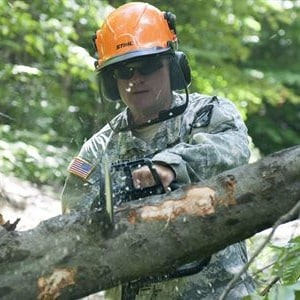 Everyone wants to know how to avoid chainsaw kickback. This is arguably the worst aspect of using a chainsaw. The term “kickback” is used to describe the abrupt and violent upward motion that occurs when your chainsaw has a problem, such as being pinched. When kickback happens, the guide bar of your chainsaw flies very suddenly upwards, usually arcing towards your face.
Everyone wants to know how to avoid chainsaw kickback. This is arguably the worst aspect of using a chainsaw. The term “kickback” is used to describe the abrupt and violent upward motion that occurs when your chainsaw has a problem, such as being pinched. When kickback happens, the guide bar of your chainsaw flies very suddenly upwards, usually arcing towards your face.
As you can imagine, this is an extremely dangerous occurrence. If you do not react in time, or if you don’t know what to do in the case of kickback, it can result in a very serious injury. While you probably won’t die, it can still scar you for life. You would probably never want to use a chainsaw again.
What Causes Kickback?
There are two main circumstances in which kickback occurs while operating a chainsaw. The first is when you touch an object with the nose of the guide bar. The nose is the tip of the chainsaw, and if this comes into contact with an object it generally causes a violent reaction, and your chainsaw lifts upwards suddenly.
The second main situation is when something pinches the chain while you are in the middle of cutting. For example, when cutting down a tree, if the cut becomes too narrow and the wood pinches the chainsaw, it will cause kickback. Kickback almost always causes the user to completely lose control of their tool, which can result in immediate injury to themselves or to someone else.
But there are other factors that contribute to chainsaw kickback. If your chainsaw is not properly maintained, if the chain is dull, if the chain tension is too loose, or if the parts and components are incorrectly installed, you may find yourself experiencing kickback.
Loose rivets, a bent guide bar, incorrectly sharpened chain cutters, improper depth gauge settings, and not paying attention also increase the risk of kickback happening. It is also good to keep in mind that the bigger the chainsaw you have, the larger potential there is for a kickback. If the chainsaw is too big and too heavy, you have less of a chance to control the machine when it lashes back at you.
Read More: How To Fix A Chainsaw – 3 Common Issues
How to Avoid Chainsaw Kickback
There are some steps you can take to reduce the risk of kickback. The first thing you need to know is about the kickback danger zone, which refers to the top part of the chainsaw’s bar. This is the area that almost always results in kickbacks. Absolutely never use the tip of the chainsaw or the area near the tip.
When this part of the bar comes into contact with an object, even something as innocent as a thin branch, there is probably going to be a reaction. The larger the bar, the more potential for a kickback, and the more dangerous it could be. Always cut with the length of the chainsaw.
By following these easy steps, you should effectively reduce your chances of having an accident.
Step 1: Before getting to work with your chainsaw, make sure you have thoroughly read the operating instructions. It is absolutely critical that you know how to use your chainsaw before you start working. By understanding the tool, you reduce the risk of an accident.
Step 2: Keep your eyes open at all times. Always stay alert when you are operating a chainsaw. If you are tired or fatigued, take a break and pull yourself together. You do not want to use this dangerous piece of equipment while you are half asleep.
Step 3: Be careful when cutting tree branches, as kickback can happen if the nose of the chainsaw hits the side of the tree, a hidden branch, or the end of a log. Cutting limbs can actually be very dangerous, and you need to make sure the area is clear when you are removing a branch.
Step 4: When cutting down a tree, always use the underside of the chainsaw bar.
Step 5: Never cut anything above your shoulders. If you have to lift your chainsaw practically above your head, rethink the situation. This is an open invitation for disaster to strike.
Step 6: Always make sure your chain brake is activated and functional before you start cutting. The chain brake will stop the chain from spinning in the event of kickback. This will mean the difference between whacking yourself in the face with your chainsaw and cutting your face open with the spinning chain. I know it sounds gruesome, but the chain brake is there to save your face – literally!
Step 7: Always have a sense of what your chainsaw is doing. Stay aware of how the chainsaw is positioned, what orientation it is in, and what could possibly happen if something went wrong.
By staying aware of your surroundings and how you have your chainsaw positioned, you increase your chances of avoiding a dangerous strike in the event of kickback.
Step 8: Always purchase a low-kickback chain. These chains are specially designed to decrease the risk of kickback. They are affordable, they still work to cut through wood, and they will keep you safe. Even if your chainsaw does not come with a low-kickback chain, go out immediately and purchase one.
This may seem like a big waste of money, but as I said before, it could mean the difference between life and death, and even having a face at all.
Step 9: Make sure you wear the proper safety equipment. Never start working with a chainsaw without full gear on. Full gear means chainsaw chaps to protect your legs, gloves to keep your hands safe, protective eyewear, like goggles or a face shield to keep the sawdust and other debris out of your eyes, and a hard hat to protect the brain inside your skull.
Read More: How To Clean A Chainsaw: Step-By-Step Guide
How To Avoid Chainsaw Kickback: Final Thoughts
You also want to wear hearing protection, as chainsaws are extremely loud. Boots are good, preferably steel-toed boots. And you don’t want to wear clothing that is too loose or too tight. Loose clothing can cause issues when you need to move quickly, and you can even get stuck on a tree branch in the middle of an accident. Not good!

